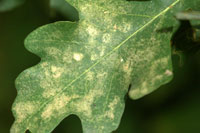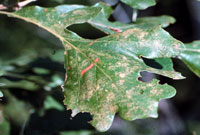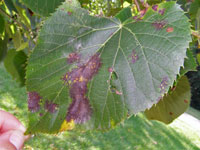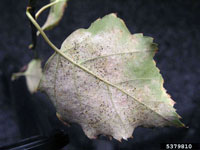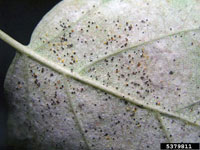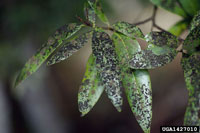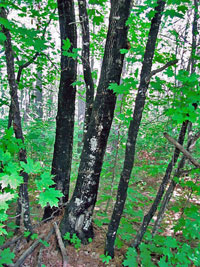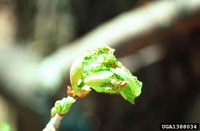Extension > Garden > Diagnose a problem > What's wrong with my plant? > Deciduous > Basswood/Linden > Dots, spots or blotches on leaves
Basswood/Linden > Leaves > Dots, spots or blotches on leaves
1 of 7
Basswood lacebugs
Gargaphia tiliae
- Needle-like mouthparts cause white or yellow speckled or pinprick discolorations that are visible on upper leaf surfaces
- Defoliation can occur when trees are severely infested
- Lace bugs are up to 1/5 inch long; light colored bodies; intricate, lacy wings
- More information on Basswood lacebugs
2 of 7
Basswood leafminer
Baliosus ruber
- Larvae feed in between leaf surfaces, creating blotch-like mines
- Mines are whitish or opaque at first but eventually turn brown
- Damage caused by the beetle larvae
- More information on Basswood leafminer
3 of 7
Linden leaf blotch
Didymosphaeria petrakiana
- Brown to blackish leaf blotches with fingerlike projections from margin
- A yellow halo may develop around the leaf blotch or the entire leaf may yellow and fall off
- Leaf spots appear in mid to late summer
- Highly infected trees will lose nearly all infected leaves by early fall
- More information on Linden leaf blotch
4 of 7
Powdery mildew
Phyllactinia guttata
- White or gray powdery mats, resembling talcum powder, occur in spots, blotches or coat leaves
- Leaves may become deformed and turn yellow and die in severe infestations
- Common on lower leaves or leaves that are shaded
- Commonly seen in spring or fall
- More information on Powdery mildew
5 of 7
Sooty mold
- Black, brown, or gray soot-like covering on leaf surfaces, or twigs
- Sticky, shiny secretions on leaves from sap-sucking insects (aphids, leaf hoppers, psyllids, etc.)
- Insects or signs of insect damage (distorted, pin-prick feeding marks, etc.) may be seen on leaves above the worst affected moldy areas
- More information on Sooty mold
6 of 7
Euonymus scale
Unaspis euonymi
- Feed by removing sap from leaves and twigs creating yellowish spots on leaves
- Severe infestations lead to branch death and defoliation
- Female scales are brownish, oblong shaped and found on twigs; immature males are white, linear shaped, fuzzy and found on leaves
- More information on Euonymus scale
7 of 7
Introduced basswood thrips
Thrips calcaratus
- Buds are attacked resulting in bud drop or deformed, ragged appearance of new leaves in spring
- Defoliation usually occurs when infestation is high resulting in a thin canopy
- Typically a forest pest, usually not a landscape problem
- American basswood is primary host
- More information on Introduced basswood thrips



